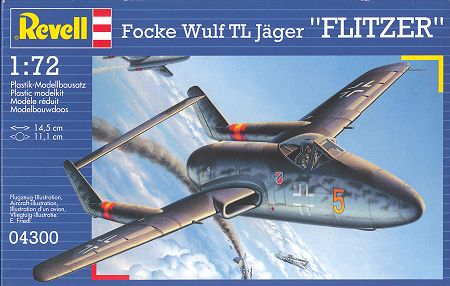
Revell 1/72 Focke-Wulf 'Flitzer'
|
KIT # |
4300 |
|
PRICE: |
$7.75 |
|
DECALS: |
2 aircraft |
|
REVIEW: |
|
|
NOTES: |
|

|
HISTORY |

It is a warm summer day in 1947, and the pilots of 6./JG 401 are lounging outside near their aircraft on the field at Ngong, just south and west of Nairobi in Kenya. The Allied troops are being forced out of the highlands area and into the areas of the south and west. It will be particularly difficult to get them out of the mountains to the west, but there are few airfields in that area so most of the air attacks will be from the south.
Oblt. Gunter Wulf looks over at his aircraft. He and his comrades have been chosen to fly the rocket-enhanced version of the Focke-Wulf FW-226 'Flitzer'. It is a very different aircraft from the one he trained in back in Germany. This one has a Walther bi-fuel rocket motor in it and when he lights it off it has him climbing into heaven like an angel. For this reason, his unit is basically a point defense staffel whose job it is to protect the supply and distribution centers of Nairobi to the north. There has been word that the Allies have been re-equipped with some fast, jet attack bombers from America, but as of yet, no one knows much about them.
His reverie is broken by the arrival of the mess truck. Ah, food! It is sure to include some of the fresh fruits that are grown in this area. Gunter joins his fellow pilots at the mess table where he digs into his lunch with great relish. While munching away, he thinks back on how he got here. After the Italians got themselves in a real mess with the British back in 1941, the Germans sent in a couple of divisions of troops and armor to help stabilize the sector until the unpleasantness with the Russians was finished in 1944. Then those units could be redeployed and finally a push was made in 1945/46 to the south to start to heard the Allies south. Here it is in July 1947 and here I am in Kenya, eating exotic foods. What a war!
The alert phone rings and the adjutant yells out that radar has detected aircraft heading their way, and they are moving very fast. Gunter races over to his aircraft. His crew has already started preparations as he climbs into his parachute and then hops up the ladder into the cockpit of his aircraft. He quickly fires up the engine and lets it build up to temperature. Taxiing out onto the main runway, he puts on the brakes and spools up the engine to full throttle. Once the aircraft starts skidding forward on its wheels, he releases the brakes. As soon as the aircraft reaches about 50 kph, he kicks in the rocket motor.
"Yee Haa!" This is what this little jet is all about! Oblt. Wulf gets slammed back in his seat by the force of the rocket and his Flitzer leaps into the sky. Gunter quickly retracts the landing gear to keep the doors from being blasted off by the speed of his pocket rocket as he quickly climbs to 2,000...5,000 and finally, a minute from takeoff, reaches 8,000 meters before the rocket cuts off from lack of fuel. "What a ride", he thinks, "this is the reason I like this bird". He then throttles the turbojet back to cruising speed and waits for the rest of his flight.
While waiting for the rest, he calls ground control for a vector to the incoming aircraft. The controllers direct him to the east, as the enemy approached from over water. "Enemy aircraft now at 102 degrees and closing very fast", he hears in his headset. Gunter wonders what he is to face. As his flight speeds along at near 750kph, he keeps looking for the enemy. "There they are!", he hears in his headset. Look down at the 11 o'clock position. Down below are about a dozen shapes, speeding along near the ground. While he cannot make out the type, he can see the specks move and their exhaust trail.
We are after some jets here. This will be tricky and difficult to get to before they reach their target. He orders the flight to dive after the enemy aircraft and to be careful not to go too fast. The little Flitzer is very unstable at high Mach numbers. Finally closing in on the bombers, Gunter notes that they are American B-43's. He can tell by the long straight wings with no engines under them and fat fuselage. These are in British markings. "One of these days we have to get the Americans to stop sending aircraft to the British." Remembering his briefing on these aircraft, he tells his crews to be very careful approaching from the rear as this bird has a sting in the rear of its wings!
Approaching swiftly, he sees the rear doors on the wings pop open and the 20mms start to track his aircraft. Both he and the B-43 seem to open fire at the same time, exchanging 20 and 30mm cannon fire. He feels a big 'Thump' as his aircraft is hit. Gunter peels off to check for damage. He checks his controls and instrument panel. Nothing obvious. Looking around his aircraft, he sees a rather good sized hole in his wing, but it seems to not have hit anything important. Might as well give it another try. By now it seems as if both attacker and defender have been successful. There are a couple of smoke trails heading for the ground and some parachutes in the sky. He spots at least one downed '43.
The battle is quickly approaching Nairobi as the surrounding flak is starting to join in the fight. Those bombers are terribly fast and seem to be outrunning the flak and fighters, now that all are at the same level. He wishes that he had another boost from his rocket!! The '43s head for the supply depot as another bomber is hit and falls to the ground in a sheet of flame. At the level they are now, there is no real chance for the crew to escape. As the bombers approach the target, he sees tiny parachutes come out of all the remaining aircraft. "They are using parabombs, he thinks. I had heard stories of these from the Japanese, but didn't think I'd see them here."
After the '43s complete their run, they head south to escape. Oblt. Wulf and his wingman will have a chance at a head to head pass before they speed out of range. They both set themselves up for about a 20 degree deflection pass. The B-43s are not supposed to have any nose armament so this should be a safe run. They both pick their targets and press in firing all their weapons. There is no returning fire as they see their cannon shells strike home. Their targets shudder under the onslaught and fall out of formation to the ground below. The rest of the striking force flashes by heading south, thier speed sufficient to prevent any additional attacks.
Gunter Wulf and his wingman return to their base at Ngong. His staffel has done well by bringing down three of the attackers. The flak got one other, but most of the bombers were successful in doing considerable damage to the supply depot. "I hope they didn't get the good German beer", Wulf thinks, "this local brew, Tusker, tastes like piss".
Reality, the Final Frontier
Looking very much like its contemporary, the DeHavilland Vampire, the Focke-Wulf 'Flitzer' may have met its near twin in combat had the war lasted into 1946. Designed in 1944, it was enthusiastically received by officials of the RLM. So much so that it was given an official designation of FW-226. There were five different designs of the Flitzer, including a Volksflitzer version. The aircraft had proceeded to the mock-up stage and ordered into production prior to the building of a prototype. However an end to the war meant that the 'Flitzer' was destined never to fly.
It's design speed, armament and other features were extremely close to that of the Vampire and it would have been interesting to see the two in combat. The 226 was to be powered by an HeS 011 turbojet and armed with two MK 108 30mm cannon in the wings and two MG151 20mm guns in the nose. The TL version which is represented by this kit, also had a liquid fuel rocket engine mounted under the turbojet This extra boost would allow it to go from the ground to 24,000 feet in about 70 seconds under the power of both motors. Projected max altitude was 46,000 feet (14,000 meters) and 516 mph (830kph), a bit slower than the turbojet only version. Imagine the problems of telling friend from foe were the types to come into contact with each other. Undoubtedly one or the other would have been marked with large color bands as was done when the P-47 came into service to prevent confusion with the similarly shaped FW-190A.
|
THE KIT |
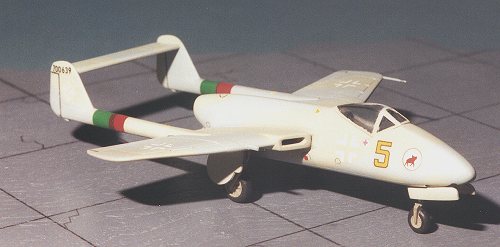
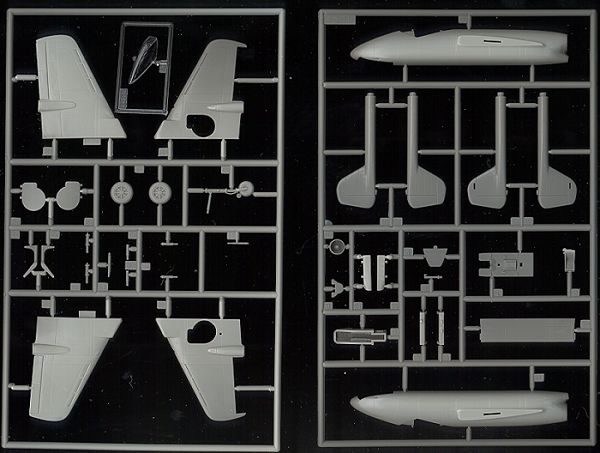 Revell's
kit of the Flitzer is superbly molded. Similar to Revell's other Luftwaffe 1946
kits, it is molded in medium grey plastic with fine etched panel lines. Cockpit
and wheel well detail are quite good and the canopy is crystal clear. With only
37 parts, it is sure to be a quick and satisfying build. Cramming sufficient
weight into the nose can be a challenge, but there is space above the nose wheel
well for the required weight.
Revell's
kit of the Flitzer is superbly molded. Similar to Revell's other Luftwaffe 1946
kits, it is molded in medium grey plastic with fine etched panel lines. Cockpit
and wheel well detail are quite good and the canopy is crystal clear. With only
37 parts, it is sure to be a quick and satisfying build. Cramming sufficient
weight into the nose can be a challenge, but there is space above the nose wheel
well for the required weight.
The instruction sheet is a single very large page on which are the obligatory warnings, color chart, parts layout, color schemes and 15 step construction process. There are two color schemes for this aircraft. Both are RLM 74/75/76. Yellow 5 in a segmented scheme with slight mottling on the fuselage and tail with red/yellow/red tail bands. Blue 10 appears to be overall RLM 76 with overall upper surface mottling in RLM 74 and 75. Undoubtedly, you can come up with some other schemes that would be more interesting!
The decal sheet is typical of Revell Germany. It is very matte with quite a bit of excess carrier that needs to be trimmed away. Naturally, there is no swastika. Also typical of their decals, they are quite good and will conform to all surfaces quite well, especially if using a mild solvent.
All in all, another excellent subject to add to the collection of Luftwaffe 'what ifs' on the shelf. I might suggest that if you want one, to get it rather soon. Two other Luft '46 subjects from Revell Germany; the Blohm & Voss P-194 and Focke-Wulf Ta-183 are no longer being produced and are very difficult to obtain.
|
CONSTRUCTION |
Those of you who have suffered through my reviews know that I start by building subassemblies. That was the case with this kit as well. Actually, it leads itself well for this. First was the cockpit. It is quite complete with floor (molded in rudder pedals), seat, stick, back bulkhead, instrument panel and side consoles. There is detail on the panel and consoles and there are seat belts molded in the very skinny seat. In fact, the pilot would have to be anorexic to be able to squeeze between the consoles!
All the interior bits were glued together and painted RLM 66 dark grey. While that was drying, the tail booms were glued together as were the wings. The wings had major warping in them so they were bent back into shape and glued. Not sure why such short pieces would have so much warp in them. The other large parts looked just fine. The instructions would have you glue the horizontal stabilizer to the tail booms prior to gluing them to the wings. Not sure if that is the way I am going to do them or not. It would make cleaning up any seams on the boom/wing join a bit difficult.
The cockpit and nose well were test fitted into the fuselage half. This showed that the back of the nose well needed a bit of sanding in order for the cockpit to properly fit. At this time the exhaust piece was glued in place. Once that was done, all the interior bits were painted RLM 66 dark grey and the gear doors and struts and wheels painted RLM 02 green-grey. When that was dry, the interior was drybrushed to bring out details.
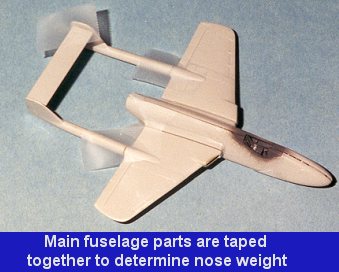 Then it was time to find space for the weight.
Then it was time to find space for the weight.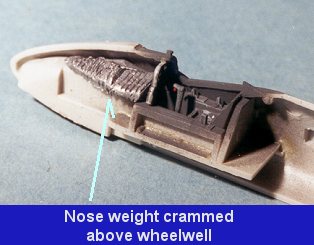 Fishing weights were cut
into pieces and crammed into the nose section as best as possible. Then the
wings, booms and tail were taped to the fuselage to make sure that the kit had
enough weight in it to sit on its gear. It would be too late once the fuselage
was glued together! Once that was completed, the cockpit was inserted and the
fuselage halves were glued together. Overall fit was very good with only a bit
of filler needed at the very nose and just in front of the canopy.
Fishing weights were cut
into pieces and crammed into the nose section as best as possible. Then the
wings, booms and tail were taped to the fuselage to make sure that the kit had
enough weight in it to sit on its gear. It would be too late once the fuselage
was glued together! Once that was completed, the cockpit was inserted and the
fuselage halves were glued together. Overall fit was very good with only a bit
of filler needed at the very nose and just in front of the canopy.
Next the wings, which had already been assembled, were attached. I was rather worried that this step would cause some problems, especially since the wings had been warped, but they fit with minimal fuss. Another day to dry and the booms and tailplane were glued into place. Plenty of time was taken to ensure they were properly aligned with each other and the wings. I'm sure a jig would have been helpful, but I am a lazy modeler and usually trust on faith and a steady hand to get these things done. This time I lucked out. After drying a bit of filler was needed on the boom attachment areas and the wing roots, but nothing major. The canopy was then attached with non-fogging superglue. Once it was masked, and the gear wells filled with damp tissue, it was off to the paint shop.
|
PAINT & DECALS |
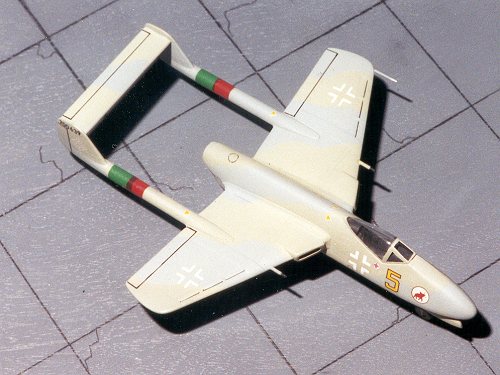
Those who have read a lot of my reviews and who know me realize that this is the real reason I build models. I just plain like camouflage and markings on aircraft. Luft '46 types are especially well liked because I don't have to be pendantic about the paint scheme and can choose anything I like. The underside of the EF.128 that was built a bit back really caught my eye. The interplay between RLM 76 blue-grey and RLM '84' blue-green was quite good and would have made the aircraft very difficult to see in the sky. So using those colors, I did a freehand scheme with the two. It seemed like something was missing, so I did a few spots in RLM 75 grey to see what it looked like.
The RLM 75 didn't make it at all so I repainted the entire airframe with RLM 84. Then the airframe was masked and a wraparound scheme of RLM 76 was painted on it. Once the tape was removed, the scheme looked pretty good.
Then it was back to the bench to have the landing gear attached. The main gear legs are butt glued to the wheel wells. The strut attachment points on the very top of the gear are molded on the wrong side of the landing gear, being toward the wingtip instead of toward the fuselage. It is no real big deal, but you need to be aware of this discrepancy. Of course, you could always attach the gear the other way around if you want. This is Luft '46 so there are no experts to challenge your choice. Once the gear had dried, it was touched up with RLM 02 and the oleos painted aluminum.
Back to the paint shop to have the gloss clear sprayed on and then it was decal time! Revell of Germany decals have several traits. They are very flat, they have more than their fair share of film around each decal, they are very thin, and finally, they fit very well. This sheet also has lots of stencils, of which I used a few, but not most of them. The only decals not on the sheet were the swastika (courtesy of Xtradecal) and the unit badge (courtesy of ESCI).
Once decaled, the final bits; antenna, pitot tube, wing guns, and gear doors were attached and the kit then given its final coat of semi-matte to seal the decals. The the masking was removed from the canopy and yet another aircraft joined the gallery of the 'never were'.
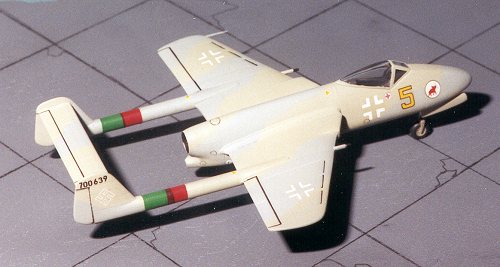
|
CONCLUSIONS |
The final result is an excellent representation of another 'paper project' from Revell. It looks great in the now growing Luftwaffe '46 collection. I can heartily recommend this kit to all but the very beginner, mostly due to the problems I had with the wings and the inherent 'fiddlyness' of aircraft with tailbooms.
|
REFERENCES |
German Jet Genesis, by David Masters, 1982
Jet Planes of the Third Reich; Secret Projects Vol 1 by Manfred Griehl , 1999
Review copy courtesy of me and my wallet!!
Copyright ModelingMadness.com. All rights reserved. No reproduction in part or in whole without express permission from the editor
If you want your product reviewed fairly and fairly quickly, please check the Product Submission link or contact the editor.
Back to Reviews Page 2015